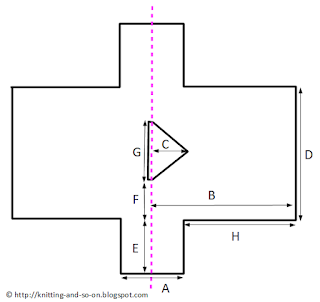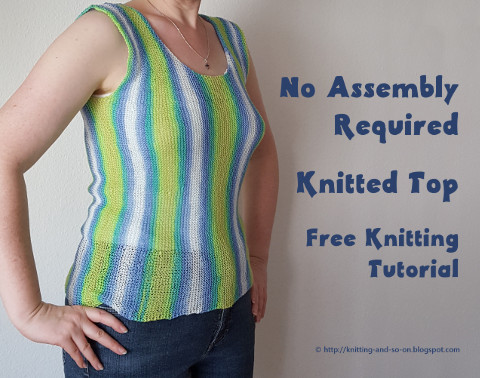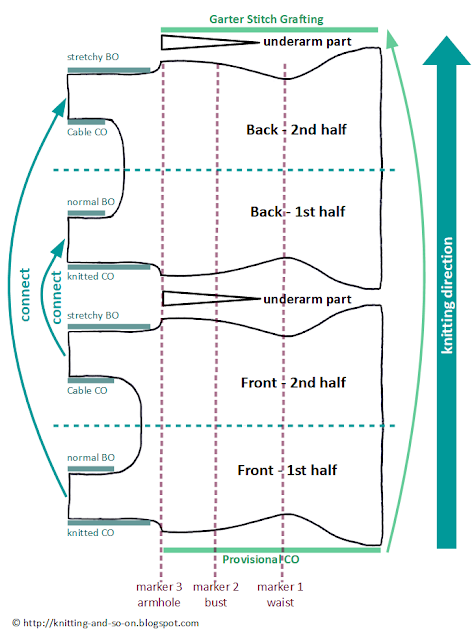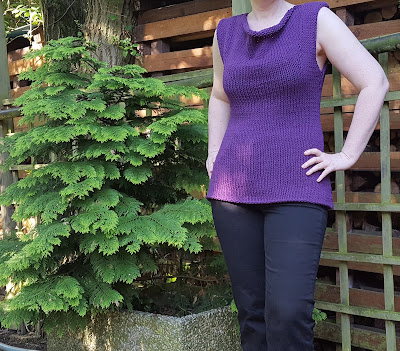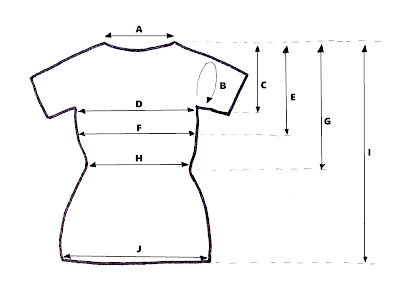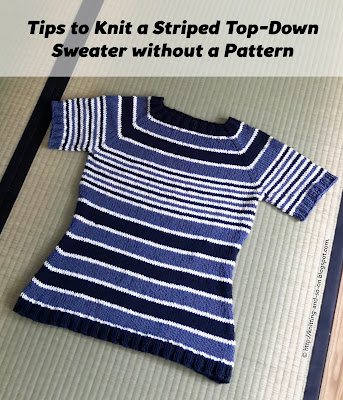Usually, I'm the queen of unfinished sweaters. But for once I finished this summer tunic and I'm quite proud about it. I made
a similar one last year but I honestly didn't like the front part (too many short rows) - so I did it again with a straight front part.
Knitted nearly all in garter stitch - except for the very short sleeves, this sweater is great to bring out the color combinations of variegated yarn. It is knitted flat - again except for the sleeves that are knitted in the round.
Dansk / Danish: A danish translation (by
Marianne Holmen) can be
found here.

This work by
Knitting and so on is licensed under a
Creative Commons Attribution-NonCommercial-ShareAlike 4.0 International License.

This is
NOT a pattern with stitch counts for various sizes but a
tutorial on how to knit a top like this. I will however give my numbers (lengths and widths, stitch and row counts) that I used - just to provide an example (these parts of this blogpost are written in
purple).
In this post I assume that your already familiar with the general concept of a top-down raglan sweater. If you've never done this, here's a nice
blog post by Knitting Pure and Simple that explains the idea or try to read this
Raglan tutorial by
Kirsten Tendyke - or knit a top-down pattern such as
Buttercup by Heidi Kirrmaier or
Gemini by Jane Richmond. (Here's a
list of the free, knitted top-down sweaters on Ravelry; you nust be logged in to make this link work.)
Materials
- yarn - I used about 900 meters of Sports weight yarn - more specifically, I used about 5,5 skeins of Lana Grossa Elastico Print - Colorway 509 (here's the link to the yarn's Ravelry page)
- a needle that fits the yarn, I used 4.5mm circular needles
- a second knitting needle for the grafting at the end
- 4 stitch markers for the top-down raglan part
- scrap yarn to put the arm stitches on
- two safety pins or other removable stitch markers
- a tapestry needle ot weave in ends
Techniques
- Dividing for sleeves in a top-down raglan sweater and adding underarm stitches with the backwards loop cast on - as shown in this YouTube video by Roxane Richardson
- Pick up and Knit - as shown in this YouTube video by VeryPinkKnits
- How to calculate your increases for a raglan sweater: There are several calculators available on the internet:
- Grafting in stockinette stitch (aka Kitchener stitch): As shown for example in this YouTube video by WEBS - America's Yarn Store
Measuring and Swatching
Knit a swatch with the yarn and the needle that you want to use for this sweater and measure your gauge. Usually, I don't swatch - for smaller projects - even if it doesn't fit, I generally can see this early enough, i.e. after about the same time, it'd take to knit the swatch. However, everytime I skipped swatching for a sweater or something similar, I ended up just knitting a bigger swatch, like half a sweater or two thirds of a cardigan :)
Now, either measure your body or take the following measurements on a t-shirt or top that fits you well:
A = width of your neck
B = circumference of your arms
C = from shoulder to under your arms
D = half of the circumference under your arms
E = from your shoulder to your bust
F = half of your bust circumference
G = from your should to your waist
H = half your waist circumference
I = the total length of your sweater
J = half of the circumference of your hips (where you want your sweater to end
Cast on your sweater and knit the yoke
With your measurements and your swatch you can calculate your CO accordingly:
My gauge was 34 garter stitch rows (i.e. 17 ridges) to 10 cm and about 20 sts to 10 cm.
I wanted a neckwidth of about 17 cm (34 sts) and 3cm for each arm (6 sts).
Therefore my CO was 50 sts with stitch markers as follows: 2 sts (front), marker, 6 sts (arm), marker, 34 sts (back), marker, 6 sts (arm), marker, 2 sts (front),
Then start knitting the yoke according to your calculations with a raglan calculator. To be honest, I have never used any of these calculators, I prefer to do increases around the stitch markers - and stop increasing when I have reached the desired width and then going on without increasing until the yoke piece is long enough. But if you want to distribute your increases evenly over the length of your yoke or you have a bigger size, you should calculate your increases.
R1: sl1 purlwise, k all
R2: sl1 purlwise, knit to one before marker, kfb,
slip marker, kfb, k to one before marker, kfb,
slip marker, kfb, k to one before marker, kfb,
slip marker, kfb, k to one before marker, kfb,
slip marker, kfb, k to end
Repeat rows 1 and 2 until either
a) the arm part reaches your arm circumference (=B)
b) the back part is wide enough (=D)
In case of a) do only increases on the front and back piece, i.e
R2a sl1 purlwise, k to 1 before marker, kfb,
slip marker, k to marker,
slip marker, kfb, k to one before marker, kfb,
slip marker, k to marker,
slip marker, kfb, k to end
In case of b) do only increases on the arm parts, i.e.
R2a sl1 purlwise, k to 1 marker,
slip marker, kfb, k to 1 before marker, kfb,
slip marker, k to marker,
slip marker, kfbm k to one before marker, kfb,
slip marker, k to end
When both a) and b) are true, repeat only R1 until the piece is long enough to separate the arm stitches (C).
To reach my intended yoke length (19 cm), I knitted 62 rows, increasing every 2nd row up until row 60 where I only did increases in the arm parts and knitting without any increases in row 62.
I put the arm stitches on scrap yarn in the 63rd row with the following stitch count (31 (front), 64 (arm), 92 (back), 64 (arm), 31 (front). I cast on 2 sts under each arm (with backwards loop CO)
Now your yoke is finished: Knit one row and put the arm stitches on scrap yarn, i.e.
k to marker, put all stitches from here to the next marker on scrap yarn, remove both stitch markers, CO 2 with backwards loop cast-on (and put a stitch marker between the two newly cast on stitches), knit to next marker, put all stitches from here to the next marker on scrap yarn, remove both stitch markers, CO 2 with backwards loop cast-on (put a stitch marker between the newly cast on stitches), k to end.
The stitch marker you just put will be called underarm markers.
Knitting the underarm part
Now all rows are knitted in garter stitch with the first stitch slipped purlwise. All shaping is done around the underarm markers.
Calculate how many stitches you have to increase (if at all) to reach your bust width - and then calculate how to distribute them among the rows to knit (length = E-C) and then do the increase rows along the underarm marker.
R
increase = sl1 purlwise, k to one before marker, kfb,
slip marker, kfb, k to one before marker, kfb,
slip marker, kfb, k to end
Since my bust width doesn't differ much from the underarm width, I didn't increase at all. Therefore I knitted 12 cm straight down (about 42 rows with my gauge).
Now calculate how many stitches you have to decrease to reach your waist width - and then calculated how to distribute them among the rows to knit (length = G-E). Do the decrease rows along the underarm marker.
R
decrease = sl1 purlwise, k to two sts before marker, ssk,
slip marker, k2tog, k to two stitches before marker, ssk,
slip marker, k2tog, k to end
I wanted to reach my waist 43 cm from the shoulder, therefore I knitted 10 more cm straight down and then distributed my decreases over the next 4 cm (or about 15 rows) (from 45 cm width to 42 cm, i.e. 6 stitches with my gauge, ie. 3 decrease rows with 2 sts decrease per row and side).
Calculate how many stitches you have to increase to reach your hip width - and then calculate how to distribute them among the rows to knit (length = I-G) and then do the increase rows along the underarm marker.
R
increase = sl1 purlwise, k to one before marker, kfb,
slip marker, kfb, k to one before marker, kfb,
slip marker, kfb, k to end
I knitted about 5 cm straight (about 17 rows) and then I increased 8 times every 5th row. That way I widened the piece by 16 stitches per side (i.e. 8 cm with my gauge). I then knitted straight down until I had reached my intended length (about 60 cm).
Knitting the sideways front piece
Once your piece is long enough cast off and cut yarn. Try it on and put a stitch marker to the point where you want your neckline to end, Count the number of rows from the bottom to this point and count the same number on the other front edge.
Now pick up and knit this number of stitches of the selvedge of the left hand side of your front - from the bottom hem of your top up to your stitch marker. To get a nice edge I only picked up the back loops of the selvedge stitches.
Knit straight rows until you have reached the intended width - this should be roughly as wide as your neck width (A). Photo 1 (below) shows how your piece looks after a few knitted rows; it also shows the yarn ends I used as removable stitch markers to mark where I wanted my neckline to end.
To get to the height I wanted, I picked up 74 stitches from the edge. I wanted about 15 cm (a bit less than the neck width used before) - therefore I knitted 52 rows.
Make sure to end on after an even row (counting the pick up and knit row as the first).
With your second needle pick up the stitches on the other selvedge (i.e. right hand side of your piece) from the stitch marker to the bottom (if you use circulars, you can start from the bottom hem as well). Here I also picked up only the back loops (i.e. the ones closest to the WS) to get a consistent look.
Photo 2 (above) shows how the piece looks with the two needles, just before grafting.
Graft both sides together in stockinette stitch.
Sleeves
Put the arm stitches of one arm from your scrap yarn to your needle(s) and pick up 4 underarm stitches (i.e. 2 above the backwards loop CO stitches you made when you transfered the arm stitches to the scrap yarn plus 1 at each side in the gap between these stitches and the live ones). Place a stitch marker (end of round marker) in the middle of these underarm stitches.
Row 1: p2tog, purl to last two stitches, p2tog
Row 2: k2tog, k to last two stitches, k2tog
Row 3: p all
Row 4: k all
Repeat rows 3 and 4 until your sleeves are as long as you'd want them to be and bind off.
I knitted a total of 18 rounds before doing my BO round.
Do the same with the second sleeve.
Weave in ends an block lightly.













